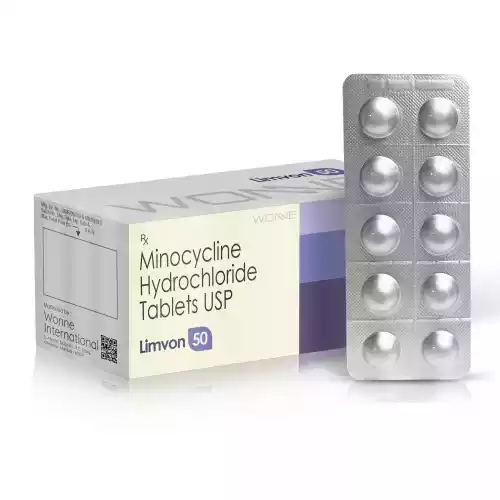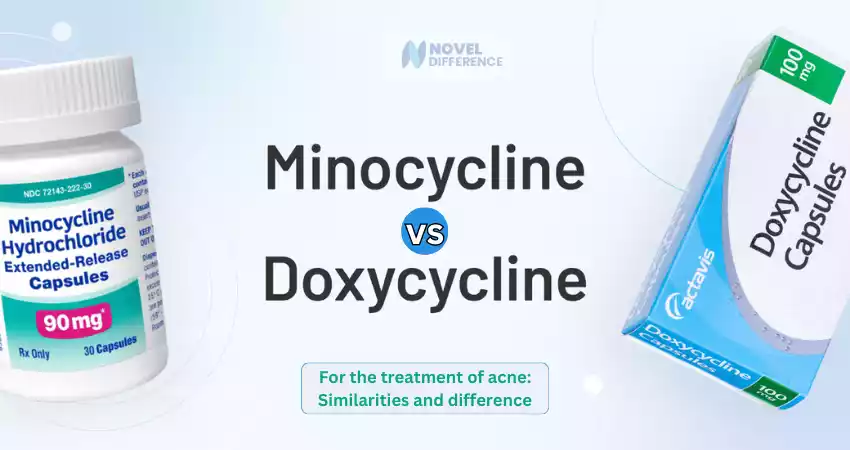Difference Between Doxycycline and Minocycline
Minocycline and Doxycycline are both commonly used antibiotics that belong to the class of tetracyclines. While they have a lot of similarities in their methods and uses they differ in their chemical structure, efficacy, and adverse impacts. Understanding these differences is essential for healthcare professionals and patients to make educated choices regarding their use when treating various medical ailments.
What is Doxycycline?
Doxycycline is an antimicrobial belonging to the class of tetracycline. It is used extensively for treating bacterial diseases which include respiratory tract infections acne, urinary tract infections as well as certain sexually transmitted illnesses.
Doxycycline is a drug that blocks the synthesis of proteins by bacteria, thus hindering the spread and growth of bacteria. It is available in many forms like capsules, tablets, and suspensions, and is chosen because of its efficacy broad range of activities, and low cost.

It also is anti-inflammatory, which makes it useful for treating specific inflammatory disorders. However, it can result in adverse effects such as gastrointestinal problems and an increased susceptibility to sunlight for some people.
What is Minocycline?
Minocycline is a broad-spectrum antimicrobial belonging to the class of tetracycline that is effective against a variety of bacteria. The drug is an ancestor of tetracycline and is a semi-synthetic substance. Minocycline is a drug that blocks the synthesis of proteins by bacteria, thereby preventing the development and reproduction of bacteria.
It is used to treat a variety of infections, including the respiratory tract, acne, and some sexually transmitted diseases. Minocycline also has demonstrated effectiveness in conditions such as Rheumatoid arthritis as well as other neurological diseases.

Similarities between Doxycycline and Minocycline
The similarities between Doxycycline and Minocycline :
- Chemical Structure: Doxycycline and Minocycline belong to the tetracycline class of antibiotics and possess similar chemical structures.
- Mechanism of Action: Both antibiotics work by impeding bacterial protein synthesis, thus inhibiting their proliferation.
- Pharmacokinetics: Both antibiotics are well absorbed when taken orally and share similar half-lives, and their distribution across the body includes lung tissue and kidney function.
- Precautions: Both antibiotics should be used with care when prescribed to those suffering from liver or kidney issues and may lead to photosensitivity (sensitivity to sunlight) for some individuals. It’s also wise not to combine them with certain other medicines like antacids, calcium supplements, and iron supplements as this could diminish their efficacy and potentially hinder treatment effectiveness.
Comparison Table
The main differences between minocycline and doxycycline
| Topics | Minocycline | Doxycycline |
|---|---|---|
| Drug class | Tetracycline antibiotics | Tetracycline antibiotics |
| Brand/generic status | Brand and generic available | Brand and generic available |
| What is the brand name? | Dynacin, Minocin, Ximino, Solodyn | Vibramycin, Doryx, Targadox, Acticlate, Periostat, Monodox, Adoxa, Oracea |
| What form(s) does the drug come in? | Immediate and extended-release tablets and capsules, injection, topical foam | Immediate and extended-release tablets and capsules, oral liquid, injection |
| What is the standard dosage? | 100 mg daily | 100 mg twice daily |
| How long is the typical treatment? | 30+ days | 10 days |
| Who typically uses the medication? | Children 8 years old and older, adolescents, adults | Children 8 years old and older, adolescents, adults |
Common Side Effects of Doxycycline
- Gastrointestinal disturbances
- Photosensitivity
- Tooth discoloration
- Yeast infections
- Esophageal irritation
- Headaches and dizziness
- Allergic reactions
Common Side Effects of Minocycline
- Gastrointestinal issues
- Dizziness or lightheadedness
- Skin changes
- Vertigo or headaches
- Tooth or gum discoloration
- Yeast infections
- Allergic reactions
Drug Interactions and Contraindications
Both minocycline and doxycycline may interact with other medications or supplements and could alter the effect or raise the chance of adverse negative effects.
Doxycycline interactions can be caused by antacids as well as magnesium, calcium, supplements, and some medications such as blood thinners, penicillin, or birth control pills which could result in hindering the absorption or effectiveness of doxycycline.
Minocycline interactions could result in a diminution of its effectiveness if it is taken in conjunction in combination with iron supplements, antacids that contain calcium, aluminum, or magnesium, and certain medicines such as penicillin and blood thinners or isotretinoin.
Both antibiotics could affect the effectiveness of hormonal contraceptives necessitating additional birth control methods in the course of treatment and for a brief period following treatment.
Furthermore, both doxycycline and minocycline come with contraindications for people who have a history of allergic reactions to antibiotics such as tetracycline kidney diseases, and pregnant women because of the potential negative effects on the development of the fetus including bone and tooth growth.
It is essential to talk with medical experts or pharmacists to discuss possible interactions and contraindications before taking these antibiotics, particularly when other medicines or health issues are in play.
Comparison chart of Cost and Availability
Here’s a comparison chart outlining the cost and availability of doxycycline and minocycline:
| Aspect | Doxycycline | Minocycline |
|---|---|---|
| Cost | Generally lower cost | Typically higher cost compared to doxycycline |
| Availability | Widely available in various forms | Available but may have limited formulations or brands |
| Generic Availability | Often available as a generic drug | Generics are available but less common |
| Insurance Coverage | Often covered by insurance plans | Coverage might vary and may be less commonly covered |
| Brand Variations | Multiple brands available | Fewer brands or formulations |
| Formulations | Tablets, capsules, suspension, etc. | Tablets, extended-release versions |
Note that the actual cost and availability may vary based on location, specific brands, formulations, insurance coverage, and other factors.
What is the alternative antibiotic to doxycycline?
Two antibiotics, azithromycin and levofloxacin are considered alternatives to doxycycline. If, however, you or someone close to you suffer from gonorrhea which hasn’t spread into other areas in the body (uncomplicated gonorrhea) Other antibiotics are suggested over doxycycline.
What are the adverse side consequences of minocycline?
This medication could cause increased pressure on your head, which could result in permanent vision loss. Talk to your doctor now if you notice that either you or your kid suffers from extreme headaches, blurred vision, or vision issues. Consult your physician immediately when rash, fever joint pain, or fatigue occurs.
Which is better doxycycline or minocycline?
The decision of whether minocycline or doxycycline is more effective is dependent on the situation being treated, specific patient characteristics, and possible negative side effects. Both drugs are part of the same class of antibiotics (tetracyclines) and possess the same effectiveness against a variety of bacteria.
Minocycline is considered to be more powerful with a more prolonged half-life needing less frequent doses as compared to the doxycycline. It is sometimes preferred in certain conditions or infections.
The choice between these two options should be determined according to factors such as the nature of the infection, the particular patient characteristics, tolerance costs, availability, and tolerability.
Can minocycline be used instead of doxycycline?
In some cases, minocycline can be used as an alternative to doxycycline. Both medications belong to the same class of antibiotics (tetracyclines) and are effective against a range of bacterial infections.
The American Heartworm Society recommends treatment by doxycycline to dogs who are suffering from heartworm disease. The recommended dosage is 10 mg/kg twice a day for 28 consecutive days. If doxycycline cannot be found Minocycline is a possibility as a possible substitute.
Summary
Minocycline and Doxycycline are two antibiotics in the tetracycline class that are used to treat a variety of bacteria-related infections. They are similar in their efficacy and bacterial coverage however, minocycline is generally thought to be more potent, with a longer duration of half-life.
Both drugs have frequent side effects, including digestive issues, and may cause tooth discoloration when younger people are taking them. There may be different combinations and contraindications.
Which one is more effective than the other is dependent on factors such as the specific illness, the particular patient’s needs, and other factors like price and availability. Consultation with a medical professional is vital in determining the appropriate treatment for the individual’s needs.


